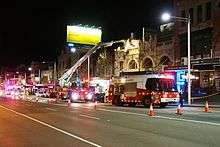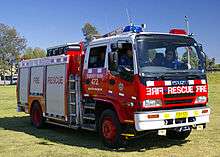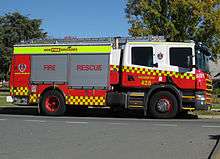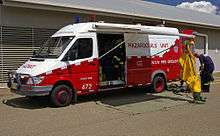Fire and Rescue NSW
 | |
|
Orta Recens Quam Pura Nites (Newly Risen, How Brightly We Shine) | |
| Operational area | |
|---|---|
| Country | Australia |
| State | New South Wales |
| Address | Level 10, 227 Elizabeth Street, Sydney, New South Wales, Australia |
| Agency overview | |
| Established | February 1884 |
| Annual calls | 186,559 (2014-15) |
| Employees |
|
| Staffing | 429 administrative and trades staff |
| Commissioner | Greg Mullins AFSM |
| Facilities and equipment | |
| Stations | 337 |
| Engines | 652 |
| Ladders | 2 |
| Rescues | 33 |
| HAZMAT | 32 |
| Aerial Pumpers | 15 |
| Aerial Ladder Platforms | 14 |
| Website | |
| Official website | |
Fire and Rescue NSW (previously known as New South Wales Fire Brigades), an agency of the Government of New South Wales, Australia, is responsible for firefighting, rescue and hazmat services in the major cities, metropolitan areas and towns across rural and regional New South Wales. Fire and Rescue NSW is the seventh largest urban fire service in the world, with over 6,800 firefighters serving at 339 fire stations throughout the state, 400 support staff, and 7,200 community fire unit volunteers.[1] FRNSW attended over 194,000 incidents and undertook 57,000 community activities in 2011/12.[2] FRNSW also works closely with the NSW Rural Fire Service in regional areas.
The agency operates pursuant to powers set out in the Fire Brigades Act 1989 (NSW) and was initially formed in 1910 as the New South Wales Fire Brigades, with its origins going back to 1884 as the Metropolitan Fire Brigade.
The agency is led by the Commissioner of Fire and Rescue NSW, currently Greg Mullins AFSM, who reports to the Minister for Emergency Services, currently the Honourable David Elliott MP. The minister is ultimately responsible to the Parliament of New South Wales.
History

The New South Wales Fire Brigades (NSWFB) was established in September 1909, replacing the Sydney-based Metropolitan Fire Brigade, which formed in February 1884.[3] Prior to its formation, Fire Brigade Boards also ran rudimentary fire services in various New South Wales country towns. On 1 January 2011 the agency was renamed to Fire and Rescue NSW to better reflect the agency's expanding responsibilities.[4]
Emblem
The Fire and Rescue NSW emblem includes the NSW state emblem with the State motto Orta Recens Quam Pura Nites, which is Latin for 'Newly Risen How Brightly We Shine'.
A flag based on the British Blue Ensign with FRNSW emblem is also used.
Commissioner
Greg Mullins was appointed Commissioner of the NSW Fire Brigades (now Fire & Rescue NSW) on 4 July 2003. He is the first person in the history of the brigade to be appointed as both Chief Fire Officer / CEO, and to have come from the Brigades’ ranks. Commissioner Mullins joined the then NSWFB in 1978 after serving for six years as a volunteer firefighter with the NSW Rural Fire Service. He rose steadily through the ranks serving in operational and specialist positions, becoming a Station Officer in 1990, a District Officer (Inspector) in 1992, a Superintendent in 1995, and an Assistant Commissioner in 1996.[5] In 2000 he was appointed as Director State Operations. A former Churchill Fellow, he has represented Australian fire services nationally and internationally on issues concerning emergency management, managing the consequences of terrorist attacks, and urban search and rescue.[5]
The Commissioner's official vehicle bears New South Wales number plate 10, which has been on continuous issue to the head of the fire department in NSW from the Roads and Maritime Services since 1910.[6][7]
Organisation
Permanent stations
A permanent firefighter is a full-time firefighter. Permanent firefighters work in a fire station as part of a platoon. Each fire station has four platoons on rotating shifts each containing at least 3 firefighters of various ranks, plus a Station Officer. The number depends on the size and nature of the fire station. Each platoon is supervised by a Station Officer. Each fire station is part of a zone containing between nine and 27 fire stations and headed by a zone commander. These zones are then grouped in regions (metropolitan, regional north, regional south, and regional west) headed by a Regional Commander.
Retained stations
A retained station is a part-time station where retained firefighters work. Even though these firefighters work part-time, it should be noted that these members of the community (who often have other full-time employment) are considered professional firefighters who have undergone training so they can attend the same jobs as permanent firefighters.[8] The retained station is not a permanently staffed station, meaning the firefighters are on-call from home or work rather than on duty at the station. However, retained stations respond to emergencies 24 hours a day. Retained firefighters use the same vehicles, equipment and uniforms as their permanent counterparts, the only visible differences being their shoulder and helmet ranks which are red as opposed to white/black.
In mid–2012, the NSW Government announced that A$64 m in employee–expense savings over four year will be cut from the budget of Fire & Rescue NSW; with resultant temporary closures of some smaller fire stations across metropolitan Sydney. The Fire Brigade Employees' Union lodged a dispute in the NSW Industrial Relations Commission,[9] with union claims that the station closures will put lives at risk.[10][11]
Mixed stations
Some stations employ a mixture of Permanent and Retained Firefighters. This arrangement is common in larger country towns such as Bathurst and Orange where the nearest backup would otherwise be some distance away. The station would typically have one appliance manned by permanent staff as first response, with additional vehicles being manned by retained staff as required. The station may have Permanent day and night shifts or be day shift only, with retained staff manning all appliances at night when they are less hampered by work or other commitments.
Community fire unit volunteers
Community fire units (CFUs) are volunteer teams of local residents trained to safeguard their homes during a bushfire, until the fire brigades can get there, or to 'mop up' after a fire has passed so fire units can be released to attend more urgent incidents. CFU members are not firefighters.[12] The aim of the CFU program is to reduce the impact of bushfires on the community and to protect life and property from bushfires. A typical team is made up of six to 12 members. Recruitment is within the local community. Local fire stations conduct regular training sessions with volunteers. The training focus is on bushfire education, prevention and preparation.
Area of service in New South Wales
Fire and Rescue NSW has 339 stations across NSW protecting 90% of the State's population from fire, and 100% of the population from hazardous materials incidents.[2][13]
Rescue

As the largest rescue provider in NSW, FRNSW responds to rescue calls throughout the State, assisting people involved in domestic, industrial and transport incidents, including road accidents. In addition, specially trained teams carry out swift water, alpine and vertical rescues, and help is also given at animal rescues. FRNSW is the lead agency for the State’s USAR capability, which deals with building collapse and other complex rescues. FRNSW USAR capability is internationally accredited and has responded to disasters such as the 2011 New Zealand earthquake and Japanese tsunami.[1]
FRNSW also works in conjunction with other government agencies including the NSW Police Force, Ambulance Service of NSW, the Rural Fire Service and the State Emergency Service.
Hazardous materials (HAZMAT)
Fire and Rescue NSW is the sole responsible agency for protecting New South Wales against hazardous materials (hazmat) incidents. The agency has the authority to attend, combat and render safe any land-based or inland waterway spillage of hazardous materials within the State. All fire stations are equipped with trained personnel and resources for dealing with hazmat incidents. Each fire station receives hazardous materials awareness training and equipment to combat minor spills of hydrocarbons, gas leaks and emergency decontamination procedures. Fire and Rescue NSW have six specialist "Heavy Hazmat" Response Units operating from strategic positions throughout the state. They have advanced capabilities in detection of toxic industrial chemicals, volatile substances and chemical warfare agents. Intermediate hazardous materials response is delivered by 14 strategically located units, including six with a waterways response capability. Each unit is equipped with detection equipment and has the capability to access chemical databases with information on chemical, biological, radiological and toxic industrial chemical substances.[1]
Additional capability is provided by a Hazmat Advisory Response Team (HART), who carry additional equipment including Raman and Infra-red spectrometers for identifying unknown solids and liquids. The HART also deploys for specialist waterway spill response and incidents requiring mass decontamination. Two Scientific Advisors also provide detailed technical assistance at incidents if required and operate a van equipped with further detection and analysis capability including gas chromatograph mass spectroscopy.
Bushfire and natural hazards
Fire and Rescue NSW supports the NSW Rural Fire Service during and after bushfires. FRNSW also conduct Hazard Reduction burns to reduce fuel loads prior to the bushfire season. The states Bushfire Incident Command Centre co-ordinates/activates the CFU units in the state and prepares training and equipment for the units and volunteers.
Counter terrorism
FRNSW participates in whole-of-government counter-terrorism planning and training activities to prepare for possible terrorist attacks. In the event of an attack, our role is to respond to fires, chemical, biological or radiological releases, building collapse and other rescue situations.[1]
Fire and Rescue NSW previously jointly funded and operated a BK 117 helicopter in partnership with the NSW Police Force Aviation Support Branch.[14] The helicopter's primary role was response during the crisis and consequence management phases of a terrorist event. It also provided general air transport of both equipment and personnel for complex and/or protracted hazardous materials or rescue incidents and firefighting operations. As of November 2014 the BK 117 helicopter was retired and replaced with a new Bell 412,[15] used for counter-terrorism and rescue purposes and now solely operated by the NSW Police Force with no joint funding or operational capacity with Fire & Rescue NSW.[16]
Fire investigation and research
FRNSW’s Fire Investigation and Research Unit (FIRU) provides a range of investigative and research services to both internal and external customers including research into human and structural behaviour during fire, and the associated impacts for performance based building design. FIRU assists with determining fire causes and liaises closely with the NSW Police Force.
Fire engines (Appliances)


All FRNSW appliances (fire engines) are custom designed. The specialised equipment to be carried on appliances is drawn from a standardised listing which forms a managed inventory and is specific to each appliance type and model. Standardisation of inventory is extremely important as this ensures equipment is stowed in an approved and ergonomic manner. It also ensures the appliance is not overloaded and is within its legal load carrying capacity.
Water tankers
FRNSW has a total of 118 4x4 water tanker appliances:[17]
| Class | Chassis make and model | Body manufacturer | Commissioned | Number | Crew capacity |
|---|---|---|---|---|---|
| Tanker Class 1 (4x4) | Isuzu FTS750 | Mills Tui Australia Pty. Ltd., Queensland | 2004 – 2011 | 58 vehicles | 4 |
| Tanker Class 1 (4x4) | Isuzu FTS | AFC | 1996 – 1997 | 53 vehicles | 6 |
Pumpers

FRNSW has a total of 419 pumping appliances:
| Class (Previous class) |
Chassis make and model | Body manufacturer | Commissioned | Number | Crew capacity |
|---|---|---|---|---|---|
| Pumper Class 2 (Pumper Type 2) | Isuzu FTR800 | Skilled Equipment Manufacturing Limited | 2000 – 2004 | 129 vehicles | 6 |
| Pumper Class 2 (Isuzu) | Isuzu FTR900 | SEM Limited | 2009 – 2010 | 120 vehicles | 6 |
| Pumper Class 3 (Varley Commander) (Pumper Type 3) | VSV Commander Mk3 | Varley Specialised Vehicles Limited | 2000 – 2005 | 53 vehicles | 6 |
| Pumper Class 3 (Scania) | Scania P320/P310 | Skilled Equipment Manufacturing Limited | 2007 – 2011 | 87 vehicles | 5 |
| Pumper Class 3 (Scania 94) (Pumper Type 4) | Scania P94 | Alexander Perrie & Co. Pty. Ltd. | 2000 – 2001 | 12 vehicles | 5 |
In 2008 the then NSWFB changed the way it designated its pumping appliances. Prior to the change, there were:
- Tankers (4x4 Ind pumper). Isuzu 4x4 FRS, FTS & FTS750.
- Type 1 (4x2 Ind pumper). Isuzu FTR800.
- Type 2 (4x2 Pto medium pumper), Isuzu FTR800 & FTR900.
- Type 3 (4x2 Pto Medium / Urban pumper), Inter 1810 & 2250, Austral Firepac, Scania 93M, Varley Commander II, Mercedes 1625, Volvo F17
- Type 4 (4x2 Pto Urban pumper) Scania 94D, Varley Commander I
- Type 5 (4x2 Pto Super Pumper). Varley Commander I SP.
Any type of appliance could be further specialised with rescue or hazmat equipment.
Due to the differences between several types being only minor, and the 4x2 Type 1 being withdrawn and rebuilt as rescue appliances, the system was simplified into 3 basic classes:
- Class 1 - 4x4 Tankers (standard, Rescue & Hazmat variants), Isuzu 4x4 FRS, FTS & FTS750.
- Class 2 - 4x2 Medium Pumper (standard & Rescue), Isuzu FTR800, Inter 1810
- Class 3 - 4x2 Urban Pumper (The old types 3, 4 & 5, in standard, rescue and Hazmat variants). Inter 2250, Austral Firepac, Scania 93M, 94D & P310, Varley Commander I & II, Mercedes 1625, Volvo F17
Aerials
FRNSW has a total of 29 aerial appliances:[18]

| Class | Chassis / aerial make and model | Body manufacturer | Commissioned | Number | Crew capacity |
|---|---|---|---|---|---|
| Aerial Pumper | Scania P340 Telesqurt | Alexander Perrie & Co. Pty. Ltd. | 2010 - 2012 | Up to 3 vehicles currently in production | 5 |
| Aerial Pumper | Scania P310 Telesqurt | Mills-Tui Ltd., New Zealand | 1999 – 2000 | 12 vehicles | 5 |
| Turntable Ladder | Iveco TT Ladders | Iveco Magirus AG / Varley Spec. Vehicles | 2002 | 2 vehicles | 2 |
| Aerial Ladder Platform 37m (Mercedes) | Mercedes K2437 Bronto | Alexander Perrie & Co. Pty. Ltd. | 1996 – 2000 | 6 vehicles | 2 |
| Aerial Ladder Platform 37m (Scania) | Scania Bronto F37-HDT | Alexander Perrie & Co. Pty. Ltd. | 2003 – 2008 | 3 vehicles | 2 |
| Aerial Ladder Platform 27m (Scania) | Scania Bronto F27-RLH | Alexander Perrie & Co. Pty. Ltd. | 2005 – 2007 | 4 vehicles | 2 |
| Aerial Ladder Platform 44m (Scania) | Scania Bronto 44-RLH | Alexander Perrie & Co. Pty. Ltd. | 2010 | 1 vehicle | 2 |
Hazardous materials (HAZMAT)
FRNSW has a total of 32 HazMat appliances[18]

| Class | Chassis make and model | Body/trailer manufacturer | Commissioned | Number | Crew capacity |
|---|---|---|---|---|---|
| BA Training Trailer | Mercedes Benz Actros 2648 (6x4) | Maxicube Trailers Pty. Ltd. | 1999 | 1 vehicle | 2 |
| HazMat Van | Mercedes Benz Sprinter | Mills-Tui Limited (Australia) | 2000 – 2006 | 14 vehicles | 2 |
| Heavy HazMat (International) | International 1850G LPV | Mills-Tui Limited, New Zealand | 1999 – 2000 | 3 vehicles | 3 |
| Heavy HazMat (Isuzu) | Isuzu 950 Long | Varley Specialised Vehicles | 2007 – 2008 | 6 vehicles | 2 |
| C02 | Isuzu/Mitsubishi | Mills-Tui Limited (Australia) | 1985/95 | 2 vehicles | 3 |
| Service/Support Vehicle | Mercedes Benz Sprinter | Caddy Storage Systems | 1999 | 3 vehicles | 2 |
Rescue
FRNSW has a total of 38 rescue appliances:[18]
| Class | Chassis make and model | Body manufacturer | Commissioned | Number | Crew capacity |
|---|---|---|---|---|---|
| Heavy Rescue (Isuzu) | Isuzu FVD1000 | Mills Tui Australia Pty. Ltd., Queensland | 2009 | 6 vehicles | 2 |
| Heavy Rescue (Isuzu) | Isuzu FVD950 Heavy Duty | Mills Tui Australia Pty. Ltd., Queensland | 2000 – 2001 | 8 vehicles | 2 |
| Heavy Rescue (Austral) | Austral Firepac 3500 | Austral Specialised Vehicles | 1995 | 1 vehicle | 2 |
| Salvage | VSV Commander Mk2 | Varley Specialised Vehicles Limited | 2001 | 1 vehicle | 6 |
| Rescue Van | Mercedes Benz Sprinter | Caddy Storage Systems | 1999 – 2001 | 4 vehicles | 2 |
| Modular (Pod) Transport System | International 2350G | Commercial Engineering and Technology /Cooks Body Works Pty. Ltd. | 1999 | 2 vehicles | 3 |
| USAR 1 | Mercedes Benz Actros 2653 (6x4) | Peki Transport Equipment Pty. Limited | 2003 | 1 vehicle | 2 |
| Reconnaissance Vehicle | Chevrolet Silverado | Caddy Storage Systems | 2008 | 1 Vehicle | 4 |
| FireAir 1 | Kawasaki BK 117 helicopter Jointly owned by Fire and Rescue NSW and NSW Police Force and used for the rapid deployment of specialist resources for tactical operations, forensic services, bomb disposal, chemical, biological, and radiological detection/decontamination, and urban search and rescue | 7 December ____ | 1 vehicle | Pilot, Co pilot and crew | |
| Incident Command Vehicle | MAN 11.160 HOCL | PMC (Adelaide), Fitted out by Fire and Rescue NSW | 1997 | 2 vehicles | 3 |
Uniform
As well as the obvious danger of heat, firefighters are exposed to toxic fumes, sharp objects, uneven ground, slippery surfaces, biological fluids, spilt chemicals and electricity.[19] Due to these hazards, firefighting uniforms need to provide the best possible protection. Firefighting ensembles are known as Personal Protective Clothing (PPC) and generally consists of tunic, flash hoods, boots, helmet, gloves, breathing apparatus, overtrousers and other assorted items such as bushfire jackets, high-visibility safety vests, cold and extreme climate clothing, and wet weather clothing.[19] In mid-2013, FRNSW issued new firefighting PPC ensembles to bring the organisation in line with the Australian Standard. This new PPC features a Nomex and Kevlar blend called Titan for the outer layer, and a moisture barrier to prevent steam burns.[20]
Community engagement
Fire and Rescue NSW engages in a variety of community training and education activities, and has partnered with GIO General[21] to promote fire risk awareness and safety. Events such as Fire Prevention Week[22] are organised by FRNSW during the year.
In 2011 FRNSW and GIO General created an advertising campaign to highlight the serious ramifications of fire in the domestic environment and to encourage people to use the free home fire safety audit tool - the advertising campaign was accompanied by a harrowing video[23] telling the story of Linda, who not only suffered a brain injury in a domestic fire, causing her to have to learn to walk and talk again, but she also lost her sister to the blaze. Additionally FRNSW worked with GIO to create a tranche of informational fire safety videos.[24]
As well as providing hands-on community support, FRNSW utilises their Twitter profile and Facebook page to engage with the wider NSW community.
See also
- Firefighting
- New South Wales Rural Fire Service
- Country Fire Service
- Country Fire Authority
- Australasian Fire and Emergency Service Authorities Council
References
- 1 2 3 4 "Overview" (PDF). Fire and Rescue NSW. Government of New South Wales. 2013. Retrieved 15 January 2014.
- 1 2 "Reported responses" (PDF). Fire and Rescue NSW. Government of New South Wales. 2012. Retrieved 19 August 2013.
- ↑ "History of City of Sydney Fire Station". Fire and Rescue NSW. Government of New South Wales. 2011. Retrieved 23 November 2011.
- ↑ "NSW firies get a new name". Herald Sun. 17 December 2010. Retrieved 17 December 2010.
- 1 2 "The Commissioner of Fire and Rescue NSW: Commissioner Greg Mullins AFSM - Biography". Fire and Rescue NSW. Government of New South Wales. 2011. Retrieved 23 November 2011.
- ↑ http://www.environment.nsw.gov.au/heritageapp/visit/ViewAttractionDetail.aspx?ID=5051488
- ↑ http://www.numberplates.com.au/plates/nsw/n10/
- ↑ "Retained Firefighters". Fire and Rescue NSW. Government of New South Wales. 10 October 2011. Retrieved 23 November 2011.
- ↑ Tovey, Josephine (30 July 2012). "Firefighters target Coalition seats for bans over budget cuts". The Sydney Morning Herald. Retrieved 10 December 2012.
- ↑ Marcus, Caroline (29 July 2012). "Budget cuts force Sydney fire stations to shut doors". The Sunday Telegraph. Australia. Retrieved 10 December 2012.
- ↑ "Closing firestations risk to community". The Australian. AAP. 2 August 2012. Retrieved 10 December 2012.
- ↑ "Community Fire Units". Fire and Rescue NSW. Government of New South Wales. 29 October 2008. Retrieved 23 November 2011.
- ↑ "Areas of Service in NSW". Fire and Rescue NSW. Fire and Rescue NSW. Retrieved 26 November 2011.
- ↑ http://www.fire.nsw.gov.au/page.php?id=241
- ↑ http://australianaviation.com.au/2014/12/nsw-police-aviation-branch-adds-two-aircraft/
- ↑ http://www.police.nsw.gov.au/news/latest_releases?sq_content_src=%2BdXJsPWh0dHBzJTNBJTJGJTJGZWJpenByZC5wb2xpY2UubnN3Lmdvdi5hdSUyRm1lZGlhJTJGNDI3NjcuaHRtbCZhbGw9MQ%3D%3D
- ↑ "Fleet Profile" (PDF). Fire and Rescue NSW. Government of New South Wales. 2013. Retrieved 15 January 2014.
- 1 2 3 "Appendix 21: Type and distribution of fire appliances" (PDF). NSW Fire Brigades annual report 2010/11. Fire and Rescue NSW. 2011. Retrieved 3 December 2012.
- 1 2 "Vehicles, equipment and technology: Uniforms and equipment". Fire and Rescue NSW. Government of New South Wales. 26 April 2007. Retrieved 27 November 2011.
- ↑ "New PPC Measures Up" (PDF). Fire and Rescue NSW. Government of New South Wales. September 2012. Retrieved 11 October 2013.
- ↑ "GIO Principle Partner". Fire and Rescue NSW & GIO. Government of New South Wales. September 2011. Retrieved 21 October 2014.
- ↑ "How GIO works with FRNSW". GIO.com.au. GIO. October 2011. Retrieved 21 October 2014.
- ↑ "Linda's story fire safety video". GIO & FRNSW. Fire and Rescue NSW. 5 May 2011. Retrieved 21 October 2014.
- ↑ "Fire Safety Videos". GIO & FRNSW. FRNSW. 1 May 2011. Retrieved 21 October 2014.
External links
![]() Media related to Fire and Rescue NSW at Wikimedia Commons
Media related to Fire and Rescue NSW at Wikimedia Commons
- Fire & Rescue NSW official website
- NSW Rural Fire Service Website
- Museum of Fire
- NSW Fire Brigade Employees Union
- Twitter profile
- Facebook page
- NSW Fire Brigade Training Facility 33°54′19″S 151°12′3″E / 33.90528°S 151.20083°E